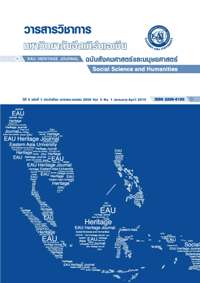การพัฒนารูปแบบการจัดสภาพแวดล้อมการศึกษาเพื่อผลิตบัณฑิต ที่มีคุณลักษณะที่พึงประสงค์ตามกรอบมาตรฐานคุณวุฒิ ระดับอุดมศึกษาแห่งชาติ สาขาพยาบาลศาสตร์ (TQF) พ.ศ.2552
Keywords:
รูปแบบการจัดสภาพแวดล้อมการศึกษา, คุณลักษณะที่พึงประสงค์, model of education environment, nursing student of desirable featuresAbstract
การศึกษาและพัฒนารูปแบบการจัดสภาพแวดล้อมการศึกษาที่มีความสัมพันธ์กับคุณลักษณะบัณฑิตที่ พึงประสงค์ตามกรอบมาตรฐานคุณวุฒิระดับอุดมศึกษาแห่งชาติ สาขาพยาบาลศาสตร์ (TQF) พ.ศ.2552 จากกลุ่ม ตัวอย่างที่ใช้ในการวิจัยเป็นนักศึกษาสาขาพยาบาลศาสตร์ที่กำลังศึกษา ชั้นปีที่ 4 ภาคเรียนที่ 2 ปีการศึกษา 2554 จำนวน 1,290 คน ผลการวิจัยพบว่า ปัจจัยการจัดสภาพแวดล้อมการศึกษาที่มีความสัมพันธ์กับคุณลักษณะบัณฑิต ที่พึงประสงค์ตามกรอบมาตรฐานระดับอุดมศึกษาแห่งชาติ สาขาพยาบาลศาสตร์ (TQF) พ.ศ. 2552 ประกอบด้วย 2 ปัจจัย ได้แก่ปัจจัยด้านลักษณะครอบครัวและปัจจัยด้านสภาพแวดล้อมสถาบัน ปัจจัยที่มีอิทธิพลมากที่สุด คือปัจจัยด้านการจัดการเรียนการสอน รองลงมาคือด้านความสัมพันธ์กับกลุ่มเพื่อน คุณลักษณะที่พึงประสงค์ ที่ได้รับอิทธิพลทางตรงมากที่สุดคือด้านความสัมพันธ์ระหว่างบุคคลและความรับผิดชอบ ผลการตรวจสอบ ความสอดคล้องพบว่ารูปแบบความสัมพันธ์ที่พัฒนาขึ้นมีความสอดคล้องกับข้อมูลเชิงประจักษ์ (มีค่าไค-สแควร์ เท่ากับ 186.77 องศาอิสระ=86 ค่ายกกำลังสองเฉลี่ยของความแตกต่างโดยประมาณ 0.03
The Development of Education Environment Model to produce Graduates having Desirable Features According to the National Higher Education Qualifications Framework for Nursing Graduates (TQF) 2009
The study and development of the education environment that is associated with the graduates by the National Qualifications Framework for Higher Education of Nursing (TQF) of 2552. Samples used in this study were nursing students to study in year 4, semester 2, academic year 2554.The results showed that factors of the environment related to the degree desired by the standards of nursing consists of two factors-family factors and environmental factors. The most influential factor is learning and teaching. The second is related to a group of friends. Desirable to have the most direct effect is interpersonal relationships and responsibilities. Results were consistent with the model developed and consistent with the empirical data. (A chi-square was 186.77 degrees of freedom = 86 are two camps, the average difference was approximately 0.03.)





